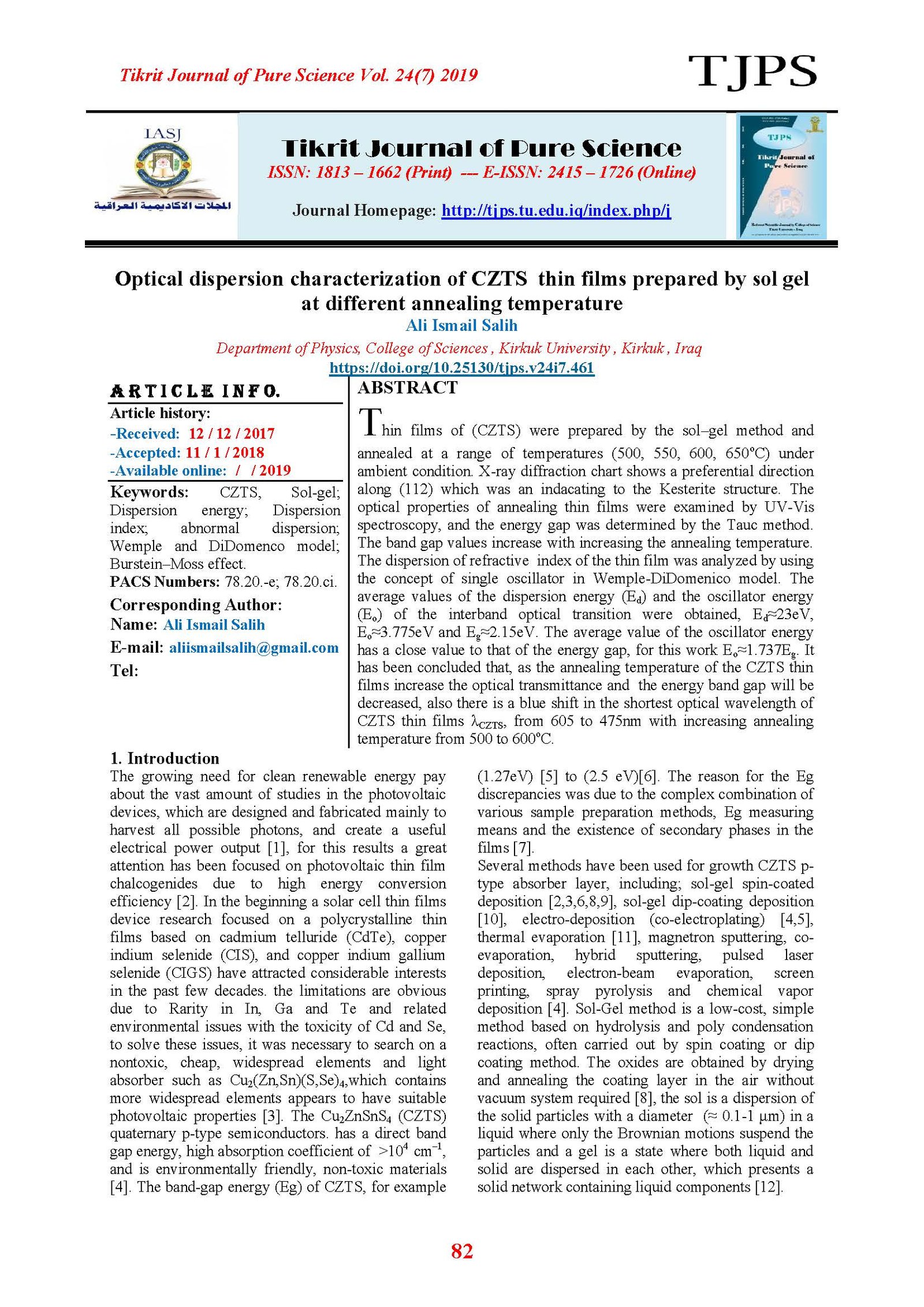Optical dispersion characterization of CZTS thin films prepared by sol gel at different annealing temperature
Main Article Content
Abstract
Thin films of (CZTS) were prepared by the sol–gel method and annealed at a range of temperatures (500, 550, 600, 650oC) under ambient condition. X-ray diffraction chart shows a preferential direction along (112) which was an indacating to the Kesterite structure. The optical properties of annealing thin films were examined by UV-Vis spectroscopy, and the energy gap was determined by the Tauc method. The band gap values increase with increasing the annealing temperature. The dispersion of refractive index of the thin film was analyzed by using the concept of single oscillator in Wemple-DiDomenico model. The average values of the dispersion energy (Ed) and the oscillator energy (Eo) of the interband optical transition were obtained, Ed≈23eV, Eo≈3.775eV and Eg≈2.15eV. The average value of the oscillator energy has a close value to that of the energy gap, for this work Eo≈1.737Eg. It has been concluded that, as the annealing temperature of the CZTS thin films increase the optical transmittance and the energy band gap will be decreased, also there is a blue shift in the shortest optical wavelength of CZTS thin films λCZTS, from 605 to 475nm with increasing annealing temperature from 500 to 600oC.
Article Details

This work is licensed under a Creative Commons Attribution 4.0 International License.
Tikrit Journal of Pure Science is licensed under the Creative Commons Attribution 4.0 International License, which allows users to copy, create extracts, abstracts, and new works from the article, alter and revise the article, and make commercial use of the article (including reuse and/or resale of the article by commercial entities), provided the user gives appropriate credit (with a link to the formal publication through the relevant DOI), provides a link to the license, indicates if changes were made, and the licensor is not represented as endorsing the use made of the work. The authors hold the copyright for their published work on the Tikrit J. Pure Sci. website, while Tikrit J. Pure Sci. is responsible for appreciate citation of their work, which is released under CC-BY-4.0, enabling the unrestricted use, distribution, and reproduction of an article in any medium, provided that the original work is properly cited.
References
[1] Aristizábal, A.J. Mika, M.A. (2016) Optical Properties of CDS Films by Analysis of Spectral Transmittance. IOSR Journal of Applied Physics, 8(4): 24-31.
[2] Li, J. et al. (2016). Optoeletronic investigation of Cu2ZnSn(S,Se)4thin-films. Science China Chemistry, 59 (2): 231-236.
[3] Guo, B. L. Chen, Y. H. Liu, X. J. Liu, W. C. and Li, A. D. (2014). Optical and electrical properties study of sol-gel derived Cu2ZnSnS4 thin films for solar. AIP Advances, 4: 097115-10.
[4] Mkawi, E.M., Ibrahim, K. M. Ali, K. M. and Mohamed, A. S. (2013). Dependence of Copper Concentration on the Properties of Cu2ZnSnS4 Thin Films Prepared by Electrochemical Method. Int. J. Electrochem. Sci., 8: 359-363.
[5] Kanuru, C. S. Shekar, G.L. Krishnamurthy, L. Urs, R. G. K. (2014). Surface Morphological Studies of Solar Absorber Layer Cu2ZnSnS4 (CZTS) Thin Films by Non-vacuum Deposition Methods. Journal Of Nano- And Electronic Physics, 6 (2): 02004-10.
[6] Chung,C. Rhee, D. Yoo, D. Choi, M. S. Heo, C. Kim, D. and Choi, C. (2013). Properties of kesterite Cu2ZnSnS4 (CZTS) thin films prepared by sol-gel method using two types of solution. Journal of Ceramic Processing Research, 14 (2): 255-259.
[7] Ahn, S. et al. (2010). Determination of band gap energy (Eg) of Cu2ZnSnSe4 thin films: On the discrepancies of reported band gap values. Applied Physics Letters, 97: 021905-3.
[8] Tanaka, K. Moritake, N. Uchiki, H. (2007). Preparation of Cu2ZnSnS4 thin films by sulfurizing sol–gel deposited precursors. Solar Energy Materials & Solar Cells, 91:1199-1201.
[9] Redha, F. W. Munef, R. A. and Salih, A. I. (2017). Effect of Concentration on Structure and morphological Properties of CZTS Thin Films Synthesized by Sol-Gel Spin Coating method. International Journal of Recent Research and Applied Studies (IJRRAS), 4(10): 50-55.
[10] Rajesh, G. Muthukumarasamy, N. Subramaniam, E. P. , Agilan, S. Velauthapillai, D. (2013). Synthesis of Cu2ZnSnS4 thin films by dip -coating method without sulphurization. J Sol-Gel Sci Technol, 66 (2): 288-293.
[11] Ben Rabeh, M. Touatti, R. Kanzari, M. (2013). Substrate Temperature Effects on Structural Optical and Electrical Properties of Vacuum Evaporated Cu2ZnSnS4 Thin Films. International Journal of Engineering Practical Research (IJEPR), 2 (2): 71-76.
[12] Brinker, C. J. and Sherer, G. W. (1990). Sol-Gel Science: The Physics and Chemistry of Sol-Gel Processing, 1st edn., Boston: Academic press, inc.:155pp.
[13] Troczynski, T. and Yang, Q. (2001). Process for Making Chemically Bonded Sol-Gel Ceramics. USA, patent No. 6,284,682, May.
[14] Chang E. K., et al. (2010). effect of carrier concentration on optical band gap shift in ZnO:Ga thin films. Thin solid film, 518: 6304-6307.
[15] Fanderlik, I. (1983). Optical properties of glass. 1st edn. Amsterda: Elesevier, 78pp.
[16] Jenkins, F. A. White, H. E. (2001) Fundamentals of Optics. 4th edn. New york: Mc Graw-Hill, 19pp.
[17] Alwan, T. J. (2010). Refractive Index dispersion and optical properties of dye doped polystyrene films. Malaysian Polymer Journal, 5 (2): 204-213.
